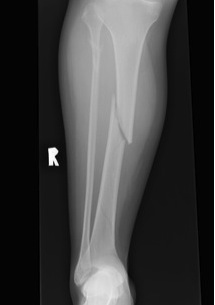Hoffa fracture
Definition

Coronal plane fracture of distal femoral condyle
- intra-articular
- often only attachment is posterior capsule
Epidemiology
Rare
Mechanism
Usually a severe valgus trauma
Xray

Coronal plane fracture of distal femoral condyle
- intra-articular
- often only attachment is posterior capsule
Rare
Usually a severe valgus trauma
Types
1. Supracondylar
2. Unicondylar
3. Intracondylar
Supracondylar / Extra-condylar
< 60 with good bone stock and preserved joint space
Union rates increased with anatomical reduction
Options
- closed reduction
- open reduction / if closed reduction fails
Accept
- no varus
- < 15o valgus
- < 10o AP plane
Garden 1 / 2
ORIF
- ~ 15% displacement rate with non operative management
- increased risk of non union
- reduced hospital in patient stays
Cannulated screws
DHS + derotation screw
Part of complex sprain / easily missed
- non operative if small
- ORIF if large and displaced
Need ORIF if displaced
- have T Achilles attached and can put skin under threat
- ORIF (usually closed reduction and screw)

Prospective multi-centred RCT
- 309 displaced intra-articular fractures
- operative v non operative management
- 2 year follow up
Findings
- used patient orientated functional outcomes
- overall VAS and SF36 not significantly different between 2 groups
Improved Operative Outcome if
- not workers compensation
- women
- < 29

Most common long bone fracture
Young patients / sports
Elderly / simple falls
MVA - often compound
Grade 0
- nil ST injury
Grade 1
Young men
FOOSH
- axial load, dorsiflexion and radial deviation
DISI occurs in ulna deviation
Type A Stable acute fracture
A1 Tubercle
2 groups
1. Elderly
- low velocity injury
- osteoporotic
- need to start bisphosphonates
2. Young patients
- high velocity injury
Distal Radius Angles
- radial volar tilt 11°
- radial inclination 22°
- radius is 11 mm longer than ulna
- ulna variance 2mm positive on average
ORIF
- > 5mm step
- > 1/4 glenoid rim and displaced
Type I
Fractures of the Glenoid rim
I A anterior
I B posterior
Differentiate from small bony Bankart